(219 products available)





































































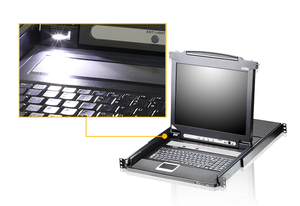
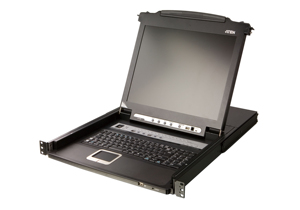
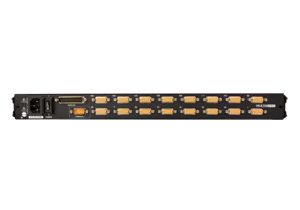






















































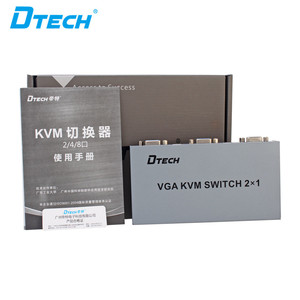







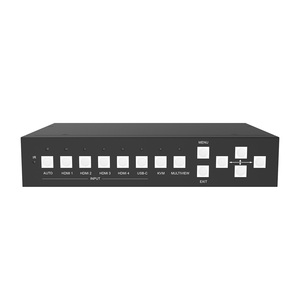




































































An HDMI VGA KVM switch allows users to control multiple computers with one set of peripherals. It is available in two main types: manual and automatic.
Manual HDMI VGA KVM switches
Generally, they are equipped with a physical button. Users can switch between different computers by pressing the button. These switches are simple and affordable. They are ideal for users who don’t frequently change computers. In most cases, manual HDMI VGA KVM switches require users to connect the cables manually. Also, users need to press the button to change output devices.
Automatic HDMI VGA KVM switches
Unlike the manual ones, automatic HDMI VGA KVM switches do not have a physical button. They changed computers automatically based on certain conditions. The conditions vary from one device to another. For instance, some models detect which computer is turned on. They automatically connect to the output devices of the active computer. In addition to this, automatic HDMI VGA KVM switches are designed to detect changes in the cable connections. When users plug in a new cable connection, these switches automatically direct the output devices to the new connection. Most models of automatic KVM switches come with cables integrated into the switch. This makes it easy to connect the devices. Moreover, the automatic type is more costly than the manual type. It is suitable for people who don’t want to use the manual switch button.
A KVM switch with HDMI and VGA cables connects a computer and a display device with HDMI and VGA ports. It allows the user to control two systems using one set of peripherals. The switch with an HDMI and VGA interface can come with multifunctional features that improve the user experience.
The primary function of the HDMI VGA KVM switch is to control two systems using one set of peripherals. Based on the numbers of systems that it can connect to, it can be a 2-port KVM switch or a 4-port KVM switch. Users only need to press the switch button of the KVM to toggle among different computers. It can be a convenient solution when the installation space is limited and only needs quick access to data in different systems. Furthermore, it can save costs on purchasing additional peripherals for each system.
HDMI VGA KVM switches are versatile gadgets with several uses across numerous industries and settings.
In the office, dual-display KVM switches are useful in streamlining productivity tasks. For instance, programmers and web developers use the switch to control many computers simultaneously, which helps in efficient coding, testing, and bug identification.
In video editing, professionals use KVM switches to manage external hard drives and other data storage devices concurrently. They also use dual monitors to import, export, and edit files simultaneously. This switch is essential for managing multimedia files quickly and effectively.
In financial trading firms, using an HDMI KVM switch allows operators to manage various computers and seamlessly access many displays simultaneously. As a result, they can keep tabs on numerous market situations and respond quickly to changes.
Using an HDMI KVM switch makes IT manageable tasks easier, like troubleshooting computer problems. By clicking a button, IT experts may switch between computers to find and fix problems, thus minimizing system downtime.
Use KVM switches in server rooms and data centers to manage computers, servers, and switches from a centralized location. Depending on the model, it is possible to access and control many servers simultaneously. This enables IT administrators to perform routine maintenance tasks like software installations, updates, and backups from a distance without needing to physically visit each server.
Gamers use KVM switches to connect game consoles and PCs to different monitors. This allows them to switch control between devices without having to constantly replug cables.
Using KVM switches in education allows teachers to control student PCs from one central location. This facilitates guiding them through assignments and troubleshooting common problems.
Here are some factors business buyers should consider when selecting HDMI VGA KVM switches for their customers.
No. of Ports
The HDMI KVM switch with VGA should have a reasonable number of ports. This will depend on the market segment. For example, a 2-port or 4-port KVM switch is ideal for small offices or home users. On the other hand, a 16-port KVM switch will attract customers who need just a single workspace to control multiple computers.
VGA Support
Consider the resolutions that the target customers use. Choose KVMs that support various VGA resolutions, such as 640x480 (VGA), 854x480 (wDVGA), 1280x720 (HD Ready), 1280x1024 (SXGA), and 1920x1080 (Full HD). Some KVM switches offer support for high resolutions like 1920x1200 or 2560x1600. This is so because some customers may want to connect to an old projector or a dual-monitor workstation.
Audio Support
Some KVM switches have VGA cables that support audio transmission. Consider this feature if the target customers need to play audio alongside the video. Such users may be working with video production applications, playing games, or using multimedia software.
Peripheral Support
The target demographics should determine the type of peripherals the KVM switch supports. For example, a basic KVM switch may only support USB connections. However, another model may allow users to connect through multimedia cards, serial ports, or Firewire.
Digital Output
To generate the VGA signal, some KVM switches convert the digital output to analog. Consider offering KVMs with good signal conversion for customers using projectors or monitors that can only accept VGA connections.
Compatibility
Look for KVM switches that are compatible with various operating systems such as Linux, Windows, Android, and Mac OS.X. This ensures the KVM meets the needs of different users.
Scalability
Business buyers should consider customer needs for future expansion. Choose KVM switches that can be easily expanded or upgraded.
Q1: How does a KVM switch work?
A1: A KVM switch permits switching between different computers using a common set of peripherals. It functions by having all computers connected to the switch via cables and the users' keyboard, video monitor, and mouse also connected to the KVM switch. Pressing a button on the switch changes which computer is connected to the peripherals.
Q2: What does HDMI KVM switch do?
A2: An HDMI KVM switch allows the sharing of multiple HDMI source devices -like computers- between a single monitor, keyboard, and mouse. It enables the user to control all the connected computers from one workstation without constantly unplugging and replugging the cables.
Q3: Does HDMI to VGA work?
A3: An HDMI to VGA converter can only be used if the target device -the VGA monitor, projector or TV- is video only. This is possible to achieve because VGA monitors cannot send a signal back to the source device -the computer or projector-, which means that if the HDMI cable is plugged out, the VGA cable cannot stay plugged in either. If, instead, the target device were a VGA laptop being plugged into an HDMI-compatible projector, the same logic could not be applied because the projector could not stay plugged in if the laptop is unplugged, as it could also not stay plugged in if the opposite were true. This means that HDMI-to-VGA conversion with audio is impossible because VGAs cannot transmit audio signal back to HDMI source.
Q4: Can a KVM switch be used with two monitors?
A4: Yes, in fact, a dual monitor KVM switch is required if the user wishes to have dual monitors at their workstation. For KVM switches to work, both the computer and the monitor must be compatible. When using two monitors at a workstation, the switch used must be a multiport model. The KVM switch must also support the same connection type as the dual monitors and the computers being used. The switch also needs to support the resolution and refresh rate of the two monitors.
Q5: What is the difference between HDMI and VGA?
A5: The main differences between HDMI and VGA are that HDMI supports both audio and video while VGA supports only video, and HDMI transmits a digital signal while VGA transmits analog. This is possible because HDMI is more modern than VGA and can transmit to more modern devices like projectors and monitors. Because HDMI to VGA converters can only work in certain circumstances, the opposite is more common and can be used anywhere because VGAs can be plugged into any HDMI-compatible device, which is more frequently found than VGA compatibility.